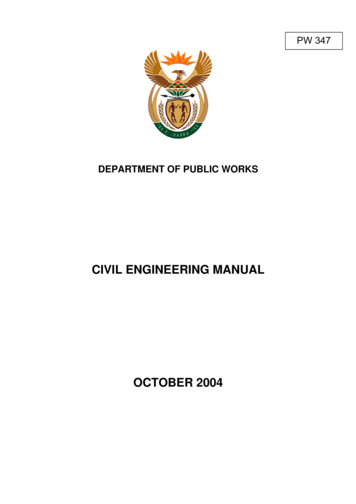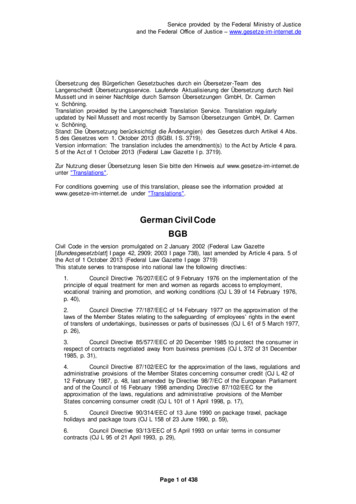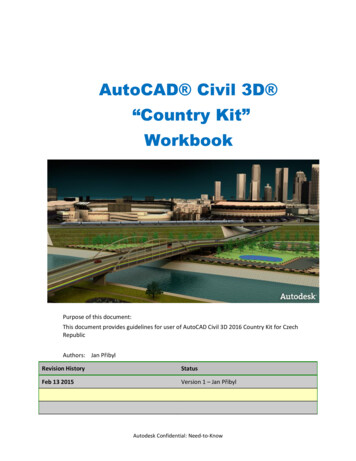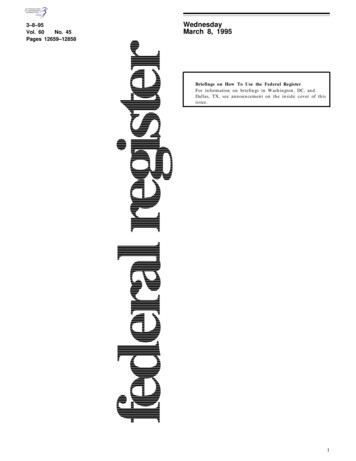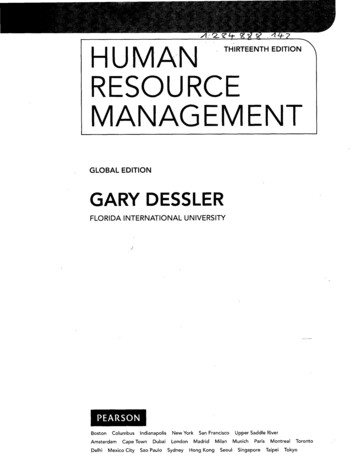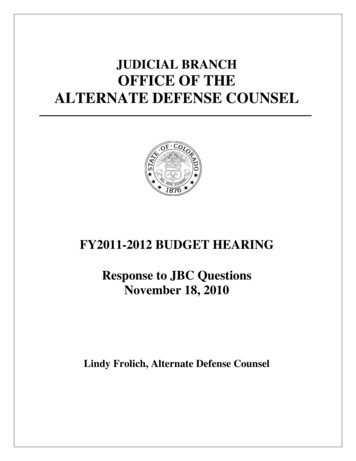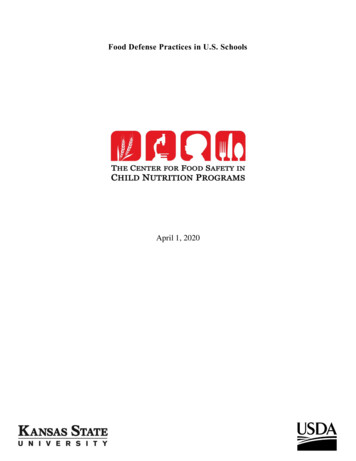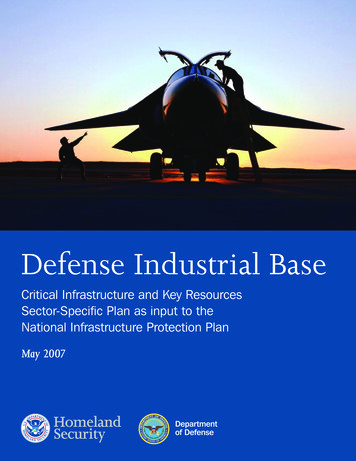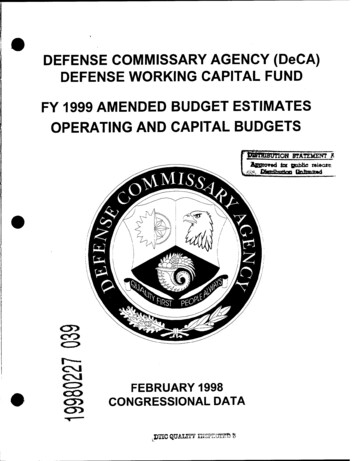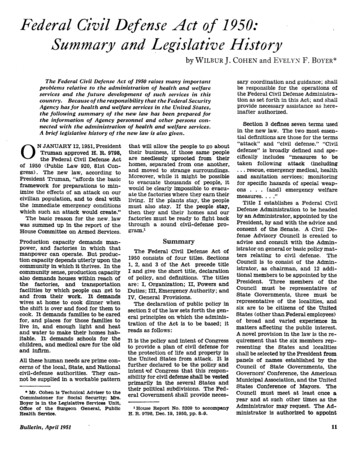
Transcription
Federal Civil Defense Act of 1950:Summary and Legislative Historyjby WILBUR J. COHEN and EVELYN F. BOYER*The Federal Civil Defense Act of 1950 raises many importantproblems relative to the administration of health and welfareservices and the future development of such services in thiscountry. Because of the responsibility that the Federal SecurityAgency has for health and welfare services in the United States,the following summary of the new law has been prepared forthe information of Agency personnel and other persons connected with the administration of health and welfare services.A brief legislative history of the new law is also given.sary coordination and guidance; shallbe responsible for the operations ofthe Federal Civil Defense Administration as set forth in this Act; and shallprovide necessary assistance as hereinafter authorized.Section 3 defines seven terms usedin the new law. The two most essential definitions are those for the termsN JANUARY 12,1951, Presidentthat will allow the people to go about “attack” and “civil defense.” “CivilTruman approved H. R. 9798, their business, if those same people defense” is broadly defined and speciilcally includes “measures to bethe Federal Civil Defense Act are needlessly uprooted from theirtaken following attack (includinghomes,separatedfromoneanother,of 1950 (Public Law 920, 81st Con. . . rescue, emergency medical, healthgressl . The new law, according to and moved to strange itation services; monitoringPresident Truman, “affords the basicto evacuate thousands of people, it for speciilc hazards of special weapframework for preparations to minwould be clearly impossible to evacu- ons . . . Candl emergency welfareimize the effects of an attack on our ate the factories where they earn theirmeasures. . . .J’civilian population, and to deal withliving. If the plants stay, the peopleTitle I establishes a Federal Civilthe immediate emergency conditionsmust also stay. If the people stay,which such an attack would create.” then they and their homes and our Defense Administration to be headedThe basic reason for the new, law factories must be ready to Aght back by an Administrator, appointed by thewas summed up in the report of the through a sound civil-defense pro- President, by and with the advice andconsent of the Senate. A Civil DeHouse Committee on Armed Services. gram. fense Advisory Council is created toSummaryProduction capacity demands manadvise and consult with the Adminpower, and factories in which thatistratoron general or basic policy matThe Federal Civil Defense Act ofmanpower can operate. But producters relating to civil defense. The1950consistsoffourtitles.Sectionstion capacity depends utterly upon theCouncil is to consist of the Admincommunity in which it thrives. In the 1, 2, and 3 of the Act precede titleistrator, as chairman, and 12 addiIandgivetheshorttitle,declarationcommunity sense, production capacitytional members to be appointed by thealso demands houses within reach of of policy, and definitions. The titlesare: I, Organization; II, Powers and President. Three members of thethe factories, and transportationfacilities by which people can get to Duties; III, Emergency Authority; and Council must be representative ofState Governments, three must beand from their work. It demands IV, General Provisions.representativeof the localities, andwives at home to cook dinner whenThe declaration of public policy inthe shift is over and food for them to section 2 of the law sets forth the gen- six are to be citizens of the Unitedcook. It demands families to be cared eral principles on which the adminisStates (other than Federal employees)for, and places for those families to tration of the Act is to be based; it of broad and varied experience inlive in, and enough light and heatmatters affecting the public interest.and water to make their homes hab- reads as follows:A novel provision in the law is the reitable. It demands schools for the It is the policy and intent of Congress quirement that the six members repchildren, and medical care for the old to provide a plan of civil defense for resenting the States and localitiesand in&m.the protection of life and property in shall be selected by the President fromAll these human needs are prime con- the United States from attack. It is Panels of names established by thefurther declared to be the policy and Council of State Governments, thecerns of the local, State, and Nationalcivil-defense authorities. They can- intent rof Congress that this respon- Governors’ Conference, the Americansibility for civil defense shall be vested Municipal Association, and the Unitednot be supplied in a workable patternprimarily in the several States andtheir political subdivisions. The Fed- States Conference of Mayors. Thel Mr. Cohen is Technical Adviser to theCouncil must meet at least once aCommissioner for Social Security: Mrs. eral Government shall provide neces- year and at such other times as theBoger is in the Legislathe Services Unit,1House Report No. 3209 to accompany Administrator may request. The AdOfflce of the Surgeon aeneral, Publicministrator is authorized to appointH. R. 9798,Dec. 10, 1950,pp. 8-9.Health Service.0Bulletin, April 1951’11
Emergency Welfare ServiceUnder wartime disaster conditions, many self-sustaining familiesand individuals may suddenly And that they have to depend temporarily on others for even the simplest essentials of life. After a disaster,a family may be left on the street without housing or adequate clothing, with no place to eat, wash, or sleep, with no means of transportation and perhaps without money or the ability to care for immediateneeds.An emergency welfare service will be necessary in the civil defenseprogram to help reestablish families, provide emergency housing, foodand clothing, locate missing persons, and care for infants, children,the aged, and the sick.In atomic disasters, thousands of families may be affected. Welfareservices are essential in order to restore civilian morale as quickly aspossible.Families or parts of familes may have to be evacuated and helpedin adjusting to strange households and communities. The communitywhich receives evacuees will need to assess its social services and expand them to support the morale of the evacuees and the receivinghouseholds. Continuing enemy attack may necessitate extensive massfeeding, clothing, and shelter, but every effort should be made to moveas rapidly as possible to individualized treatment of personal or familyneeds. To do this, every community should prepare, in advance, itsfamily welfare-service program for civil defense . . .term “welfare service”Services for individuals and families.-Theis used to cover the essential activities involved in providing materialassistance and other help on a temporary basis to individuals orfamilies until they can reestablish themselves and take up their normalactivities in home and industrial life.Material assistance in civil defense is a temporary, emergency program designed to provide civilians with food, clothing, shelter, fuel,cash, household equipment and supplies, transportation, medical care,and other items required to enable people to return promptly to productive activity.Other welfare services include:(a) Providing for rehousing or settlement for individuals and families uprooted from their homes.(b) Furnishing information to individuals on help that is availableto them, and where it may be obtained.(cl Assisting persons to take advantage of insurance or other benefits to which they are entitIed.(d) Referring persons to available employment, retraining, vocational rehabilitation, medical services, and specialized child welfareservices.(e) If necessary, providing for children to be separated from theirparents on the best basis possible and with the least shock.Source: National Securitychapter 17, pp. 80 and 74.Resourcesother advisory committees as he deemsnecessary.Title II relates to the power andduties of the Administrator;it describes the Administration.‘s functionsin detail and sets forth the basis uponwhich the Federal Government will12Board,UnitedStates CivilDefense,make financial contributions to theStates. The law authorizes the Administrator to undertake ten functions: (11 preparation and sponsorship of national plans and review ofand report‘ on State plans and programs: (21 coordination of civil de-fen.% activities of Federal agencies;(3) provision for civil defense communications and dissemination ofwarnings of enemy attacks; (4) development of measures to afford adequate protection of life and property,including development of shelter designs, equipment, and facilities; (5)provision for training programs; (6)dissemination of information; (7) assistance and encouragement to theStates to enter into interstate compacts; 18) construction, lease, and distribution of materials and facilities;(9) administration of Federal grantsm-aid to the States; and (101 provision for sale of surplus materials.Title III gives the basis for the useof certain emergency powers. Section301 stipulates that the provisions oftitle III shall be operative only duringthe existence of a state of civil defense emergency and that the “existence of such emergency may be proclaimed by the President or by concurrent resolution of the Congress ifthe President in such proclamation,or the Congress in such resolution,finds that an attack upon the UnitedStates has occurred or is anticipatedand that the national safety therefore requires an invocation of theprovisions of this title. Such emergency also shall exist with respect toany designated geographic area orareas of the United States when thePresident determines that any suchattack has been made upon or is anticipated within such area or areas,and directs the Administrator to proceed pursuant to the provisions of thistitle with respect to such area orareas. Any such emergency shall terminate upon the proclamation of thetermination thereof by the President,or the passage by the Congress of aconcurrentresolution terminatingsuch emergency.”During the period of such emergency, Federal agencies are authorizedto make their personnel, materials,and facilities available to the Administrator for the aid of the States;provide emergency shelter; and makerepairs to, and temporary replacement of, communications, hospitals,utilities, transportation facilities, orpublic facilities damaged or destroyedby attack. Among other things, theAdministrator is authorized by section 303(e) to “provide financial asSocial Security
sistance for the temporary relief oraid of any civilian injured or in want8s the result of any attack.” Theemergency provisions of title III terminateon June 30. 1954, or on suchearlier date as may be prescribed byconcurrent resolution of the Congress.Title IV. contains various generalprovisions, including provisions relating to administrative authority, security regulations, and utilization ofexisting facilities. Section 409 authorizes the Reconstruction Finance Corporation to purchase securities ormake loans for the purpose of aidingin fmancing civil defense projects.The total amount of loans outstanding at any one time can never exceed 250 million.SignificantProvisionsThere are a number of signiilcantprovisions of the new law that diiferfrom those that governed civil defenseactivities during World War II. Someof these provisions are of special interest to persons concerned withhealth and welfare.A most important difference is thatduring World War II the entire civildefense program, including civilianwar assistance, benefits, and medicalcare, was established by Executiveorders.2 The new legislation is thefirst law dealing with civil defensematters that Congress has everpassed.Federal Grants to StatesThe new law clearly places majorresponsibility on the States for sharing the cost of civil defense. It is estimated that the cost for the wholeprogram will be approximately 3.0billion over a period of 3 years, ofwhich about 1.7 billion or 54 percentwill be borne by the Federal Government.3James J. Wadsworth, then ActingDeputy Administrator of the Civil Defense Administration, 4 pointed out atthe Senate hearings that the paramount consideration in planning and“For 8 summary of the various civilianassistanceprogramsestablished by Executive order see “War Civillen SecurityProgram.” So&al Security Bulletin,June1943.*Senate Report No. 2683to accompany5. 4268, Dec. 19. 1960,p. 6.4The Administration was createdby Bxecutive order, Dec. 1, 1960.Bulletin, April 1951Health ServicesMaintenance of usual health services during wartime is the reSPOXXibility of existing health agencies and individual professional and technical health experts. The relief of suffering immediately after a civilianwartime disaster, the provision of emergency lifesaving measures, thepreservation or restoration of health services normally existing inpeacetime, are the responsibilities of civil defense.In view of technical and professional requirements. the civil defensehealth and medical measures and services must continue to remain aresponsibility of existing health agencies and individuals. Theseagencies and individuals will perform their wartime functions undercivil defense rules and regulations.Close liaison between civil defense organixations and peacetimehealth services is therefore imperative. Existing health agenciesshould, in wartime, be responsible for civil defense health requirementsso that creation of new duplicating agencies will be avoided.This principle has been followed in the planning of Federal civildefense health services. The United States Public Health Service hasagreed to provide medical and other ofacers to staff Federal civildefense central and regional ofllces.Initially this function may be carried out through the health personnel assigned to existing Federal Security Agency regional offices.Later the function will be moved to wherever the Federal regional civildefense offices are established.In each State, the State health officer should be placed in chargeof all State civil defense health and medical services; and cities shouldappoint local health officers in the same manner.These officers should be integrated into the State and State areacivil defense organizations. In addition, the State civil defense advisory council, if created, should include representatives of each of themajor State organizations of professional health experts. The members of these organizations would contribute personal services extensively in time of a disaster, and their advice and assistance during theplanning stage will be invaluable.An enemy attack on American cities using new technological weapons might introduce some new medical and health problems fromsuch effects as radiation and chemical and bacteriological contamination. In the majority of cases however, such an attack would onlymultiply many times the recurrence of familiar problems.Training for professional, technical, and auxiliary lay personnelwill be necessary to prepare for the new problems. Thorough organization will be necessary to provide adequate professional and technicalpersonnel; and also the supplies, hospitals, and related facilities forthe care of the many thousands of casualties which could occur amongthe civilian inhabitants of a large city.This increase in casualties will require many auxiliary volunteerworkers to be recruited and trained, in order to supplement the services of available professional and technical personnel.Source: National Security ResourcesBoard, United States CiviZ Defense,chapter 16,pp. 59-60.financing civil defense was that “adequate preparation against the loss oflife and property is of primary contern to the affected community” andthat the plan for civil defense “re-quires substantial financial outlaysby State and local governments.”The plan for financing that was finallydeveloped and included in the law,with minor changes, provides:13
1. That the cost of local personneland administration, together with thecost of supplies and of personal equipment needed by volunteer workers,be the financial responsibility of theStates and local communities.2. That the Federal Governmentshare with the States and local communities the cost of procuring suchheavy equipment as may be necessaryfor augmented fire services, engineering services, transportation services,communications services, and rescueservices.3. That the Federal Governmentmatch equally the expenditures of theStates and cities for the constructionof communal-type shelters.4. That the Federal Governmentprovide regional stdckpiles of critically needed materials, particularlyof those types that would not otherwise be available in the event of anemergency. (Such materials wouldinclude engineering supplies, bloodplasma, medical supplies, and evacueesupplies.)5. That the communications andcommunication control centers necessary to distribute timely and adequatewarning of an enemy attack be provided by the Federal Government.6Section 201 (i) of the law lists theconditions on which the Federal Government will make financial contributions to the States for civil defenseprograms and projects. A significantfeature is that none of the FederalGovernment’s contribution “shall bemade for State or local personnel andadministrative expenses, or for itemsof personal equipment for State orlocal workers” with the exception of“compensation paid to and the transportation, subsistence, and maintenance expenses of any employees whileengaged in rendering civil defense aidoutside the State” during the periodof an emergency. The reason for thisprovision is that civil defense is regarded as primarily a responsibilityof the State and local communities; itis felt that State and local governments should assume as much of theresponsibility, including financing, aspossible. It is further felt that Stateand local civil defense agencies should5 Hearings Before a SubcommZttee of theSenate Committee on Armed Services onS. 4217 and S. 4219 (81st Cong., 2d sess.),p. 60.14recruit and pay their own staffs toemphasize the fact that civil defenseis their program and not one imposedupon them by the Federal Government.In general, the law permits the Administrator to make Federal financialcontributions to the States “on suchterms or conditions as the Administrator shall prescribe,” except that certain aspects--such as the method ofsharing the cost of shelters and otherprotective facilities-arespecificallywritten into the law. For such shelters and protective facilities, the Federal contribution must be equallymatched by the State. Federal fundsfor this purpose are to be apportionedamong the States in the ratio that theurban population of the critical targetareas in each State bears to the totalurban population of the critical target areas of all States. The criticaltarget areas are to be determined bythe Administrator after consultationwith the Secretary of Defense.as a consequence of any enemy attack.?During World War II a program offinancial assistance was establishedby Executive allocations providing forcompensation to or on behalf of civilian defense workers and civilians dlsabled or killed as a result of enemyaction. A single schedule of compensation was used for both groupsof persons. Extensive hearings wereheld on proposals embodying such aprogram in legislative form, 8 but thelegislation was never enacted and theProgram continued throughout theduration of World War II under temporary Executive allocations or annualappropriations.Section 304 of the new law providesthat the Federal Government is notliable during the period of an emergency for death, injury, or propertydamage resulting from the actions ofany Federal agency or employee incarrying out the provisions of titleIII. This provision does not, however,affect the right of any person to receive any benefit or compensation toHealth and Welfare Aspectswhich he might otherwise be entitledIt has already been noted that the under the Federal Employees Comdefinition of the term “civil defense” pensation Act or any other law proincludes “emergency” health and wel- viding for any pension or retirement.The development and administrafare services and that the emergencytionof the civil defense program inpowers of the Administrator authorize him to “provide financial assist- volve dependence on existing agenciesance for the temporary relief or aid responsible for health, education, soof any civilian injured or in want as cial security, welfare, and relatedthe result of any attack.” The Act programs. The Act recognizes thealso provides that during the period role of existing Federal, State, andother agencies by speclflcally providof an emergency the Administratoring in section 405 (2) that the Adshall “coordinate and direct, for civilministrator shall “utilize to the maxidefense purposes, the relief activitiesof the various departments and agen- mum extent the existing facilities andcies of the United States as providedin section 302.”’ For a detailed report and an evaluationThe Act is silent with respect to of the effects of World War II on healthwork accident compensation for State and welfare services in Great Britain, seeM. Titmuss, PTObk77Zs of Socialemployees B or a long-run program of RichardPolicy, London, 1950.financial assistance, medical care, orBefore a Subcommitteeofrehabilitation for the relief or aid, the8 HearingsSenate Committee on Educatton andafter the termination of “temporary”Labor on S. 2412 (77th Cong., 26 sess.)aid, of civilians injured or still in want1942; Senate Report No. 1448 to accom H. R. 9689 (introducedSept. 18, 1950)provided that in the event of an emergency or disaster resultingfrom enemyattacks the Federal Civil Defense Administrator would be authorized and directedto reimburse the State or politicalsubdivision for work accident compensationin the case of employees of a State orpoliticalsubdivisionrendering assistanceoutside the State.pany S. 2412, June 8.1942. (The provisionof S. 2412 relating to civilian war benefits was stricken from the bill on theSenate floor because it came within thejurisdictionof the Senate Committee onFinance. CongressionalRecord, June 22,1942, p. 5426.) Heartngs Before a Subcommittee of the Senate Committee on Finance 0; S. 2620 (77th Cong., 2d sess.),1942; Hearings Before a Subcommtttee ofthe Senate Committee on Finance on S.450 (78th Cong., 1st sess.) , 1943.Social Security
rf2mw.m of the Federal Government,and. with their consent, the facilitiesand resources of the States and localpolitical subdivisions thereof, and ofother organizations and agencies.”The law also specifically provides insection 405 (3 1 that the Administratorshall “refrain from engaging in anyform of activity which would duplicateor parallel activity of any other Federal department or agency unless theAdministrator,with the writtenapproval of the President, shall determine that such duplication isnecessary to accomplish the purposesof this Act.”LegislativeHistoryAction in the House of RepresentativesH. R. 9798 was introduced by Representative Durham. Hearings wereheld by a subcommittee of six members of the Committee on ArmedServices, three of whom were alsomembers of the Joint Committee onAtomic Energy.12 A new bill, in thenature of a substitute, was reportedout on December 19. 1950. The billwas considered and passed by theHouse of Representatives on December20, 1950.15 Four amendments wereproposed, two of which were adopted.An amendment offered by Representative El&on was adopted that provided for termination of the programon June 30,1954, or on adoption at anearlier date by Congress of a concurrent resolution. RepresentativeJudd proposed an amendment, whichwas adopted, requiring security clearance of employees by the Administrator “in writing.” An amendment byRepresentative Javits was rejected; itwould have stricken out the prohibition of Federal financial participationin the cost of self-liquidating projects.An amendment that would have provided for the establishment of a voluntary home-front army, proposed byRepresentative Edwin Arthur Hall,was rejected. The bill passed theHouse, 247 to 1.It required nearly 4 months to enactthe bill into law. The ihst version ofthe bill was introduced on September18, 1950, and the final version wasapproved by President Truman onJanuary 12, 1951.On September 18, 1950, PresidentTruman transmitted g to the Congressthe national civil defense plan prepared by the National Security Resources Board.‘O The President urged“the members of Congress to considerthis legislation in the near future.”The bill prepared by the NationalSecurity Resources Board was introduced on the same day into the Houseof Representatives (H. R. 9689) andon September 19. 1950, in the Senate(S. 4162). During October and No- Action in the Senatevember, detailed suggestions for reS. 4268 was introduced Decembervisions were received from many19,1950, by Senator Chapman (fordifferent groups. A revised bill wasintroduced on November 30, 1950, Senator Kefauver) of the Senatein the House (H. R. 9798) and on Committee on Armed Services. TheDecember 1, 1950, in the Senate bill was the same as H.R. 9798 as reported out by the House Committee.14el. 42191. Eight amendments were consideredQCongressionalp. 15245.Record,Sept. 18, 1960,‘0 NationalSecurityResources Board,United States Civil Defense, 1950. TheFederal Security Agency assisted in thepreparationof the chapters dealing withhealth and welfare services. See also twoeaklier reports on civil defense: War Department Civil Defense Board, A Study ofCivtZ Defense, February 1948; and Office ofCivil Defense Planning, CiviZ Defense forNatinaZSecurUy, A Report to the Secretary of Defense, 1948.“For a brief chronologyof the stepstaken in civil defense matters since 1916,as well as the history of civil defenselegislationin 1950, see House Report No.3209 to accompanyH.R. 9798,pp. 10-13.Bulletin, April 195112Subcommittee HearZngs on H. R. 9798,to Authorize a Federal Civil Defense Program (No. 224). Dec. 6, 1950; and FUZZCommitteeHearings on H.R. 9798 (No.225), Dec.16,1950.l*CongressionaZRecord, Dec. 20. 1950,pp. 16997-17020.‘“Hearinason civil defense were held.by the Joint Committee on Atomic Energyin March and April 1950. Hearings on S.4217 and S. 4219 were held in December1950 by a subcommitteeof the SenateCommittee on Armed Services. These billswere referred to the Committee on ArmedServices rather than the Joint Committeeon Atomic Energy by decision of the VicePresident.(CongressionalRecord, Dec. 4,1950, pp. 16192-16193.)in the Senate. Six were adopted-allby a voice vote-and two were withdrawn.‘ The ilrst amendment adopted wasoffered by Senators Ives and Flanders.It provided for certain procedures tobe followed in compensating for Private property acquired. The amendment added the substance of theprovisions included in title II of theDefense Production Act of 1950.The second amendment adoptedwas proposed by Senator McMahOn.Chairman of the Joint Committee onAtomic Energy. His amendment provided that in the selection of criticaltarget areas the Civil Defense Administrator should make his determinations after consultation with theSecretary of Defense. Senator McMahon justifled his amendment on thegrounds that “the Administratormight well find it easier to execute thedecisions made if the decisions restednot only upon his judgment of thesituation, but upon the consideredadvice of the Secretary of Defense,who, of course, will be in consultationwith the Joint Chiefs of Staff.”An amendment offered by SenatorBridges was adopted; it provided fora check by the Civil Service Commission of the loyalty of civil defense personnel, to be followed by a full investigation by the Federal Bureau ofInvestigation if there should be anyindication that the individual mightbe of questionable loyalty or reliability.A fourth amendment was offeredby Senator Taft with respect to thetime that a state of civil emergencywould begin and continue in effect.The Taft amendment was adoptedas amended by Senator Holland sothat declaration of a state of emergency shall apply only to any “exposedarea or areas, as, for instance, inAlaska, Hawaii, or at the Canal Zone.”The amendment would not requireany public proclamation by the President but would require that the ArmedServices Committees of Congress beadvised of the determination.A Afth amendment was offered bySenator McCarran to strike out thesection of the bill relating to immunity from suit because of death, in1bCongressional Record, Dec. 22, 1950,pp. 17136-17163.15
law already provided that the ReconstructionFinance Corporationcouid make loans only to self-liquidating projects.Upon completion of amendments toS. 4268, the Senate took up H. R. 9798,as passed by the House, and struckout all of the House bill and substituted the language of the Senate bill,as amended. The bill then passed theSenate on December 22, 1950, andwent to conference.jury, or property damage resultingfrom civil defense during an emergency, and the section relating to thewaiver of the AdministrativeProcedures Act. Senator Kefauver, incharge of the bill on the floor, firstopposed the McCarran amendmentbut later agreed to take it to conference for further study.The sixth amendment was offeredby Senator Kefauver for Senator Cordon. It amended the provision ofparagraph (f) of section 303 of S. 4268to read “and to incur such obligationson behalf of the United States as maybe required to meet the civil defenserequirements of an attack or imminentattack.”Both amendments that were withdrawn had been offered by SenatorTaft. The first related to a termination date for the program, while thesecond related to the section in thebill authorizing the ReconstructionFinance Corporation to make loansfor self-liquidating projects. The terminal-date amendment was withdrawn so that the conference couldwork out a compromise solution. Theother amendm
Federal Civil Defense Act of 1950: j Summary and Legislative History by WILBUR J. COHEN and EVELYN F. BOYER* The Federal Civil Defense Act of 1950 raises many important problems relative to the administration of health and welfare services and

